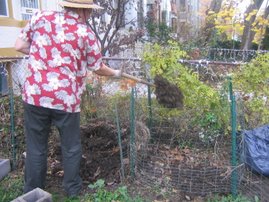 In our house it was customary the day after Thanksgiving to divide the carcass and start a huge pot of turkey stock. The house would fill with the unmistakable aroma of turkey on the stove, a signal to one and all that we would soon be embarking on a week-long mission to consume as much turkey soup and leftover turkey as possible. Thus did we give proof to the adage that when something is in season, you eat it until it's gone.
In our house it was customary the day after Thanksgiving to divide the carcass and start a huge pot of turkey stock. The house would fill with the unmistakable aroma of turkey on the stove, a signal to one and all that we would soon be embarking on a week-long mission to consume as much turkey soup and leftover turkey as possible. Thus did we give proof to the adage that when something is in season, you eat it until it's gone.It seems axiomatic that when the Thanksgiving feast is over, something of a turkey penury begins. My wife, for instance, loves the holiday--loves all the preparations and the family gathering and the protocols of the meal--but hates leftover turkey. I can remember an infinite number of turkey sandwiches--is there anything more delectable than the combintation of turkey, mayo and cranberry sauce?--as well as the slogging through of the first turkey-a-la-king, followed by the seemingly interminable nights of leftover turkey-a-la-king.
Personally, I love turkey sandwiches and turkey-a-la-king, preferably with cremini mushrooms. And for all those cooks who dread the onslaught of leftovers, there is this thought: freeze it.
We will not have nearly so many leftovers as a 31-pound bird might produce, because everyone who joined us for Thanksgiving dinner had a package of leftovers thrust at them before they could exit the house. Still, the ca
 rcass I saved in the cooler is a pretty large one and will make a generous quantity of stock.
rcass I saved in the cooler is a pretty large one and will make a generous quantity of stock.Use this for turkey soup, of course, but also to enhance that turkey-a-la-king sauce, to put some spark into a turkey chili, perhaps, and for soups with beans and hearty greens. Perhaps you have some favorite uses for turkey stock? By all means, send them along.
The process is almost identical as for a chicken stock. The main point is to break up the bones to extract as much flavor and collagen as possible. A good stock should be quite gelatinous once it is refrigerated. I use a heavy cleaver to crack the carcass into numerous pieces. In fact, I need two pots for this operation.
At the bottom of a large pot, place an onion sliced in half, two carrots broken into pieces, two celery stalks broken into pieces, a fistfull of leafy parsley stems, several sprigs of thyme, two bay leaves and a dozen pepper corns. Cover these with pieces of the carcase, leg bones, wing bones, etc. Cover with cool water and place a heavy object on top to hold everything down. I use a stainless, collapsible steaming basket, but a ceramic plate also works to hold all of the solid contents under the surface of the water while it cooks.
 Bring the liquid almost to a boil, then reduce the heat to a simmer where bubbles are occasionally breaking the surface. You do want to cook the stock, but boiling and roiling will make the stock cloudy. Continue cooking for three hours or more, until the stock is quite flavorful. Remove the pot from the heat.
Bring the liquid almost to a boil, then reduce the heat to a simmer where bubbles are occasionally breaking the surface. You do want to cook the stock, but boiling and roiling will make the stock cloudy. Continue cooking for three hours or more, until the stock is quite flavorful. Remove the pot from the heat.Allow the stock to cool a bit and collect itself. Then use a slotted spoon or (my favorite) a Chinese spider to remove all the solid contents from the pot. Pour the stock through a fine sieve to remove all the remaining particles. Clean out the cookpot and return the stock to it. Refrigerate overnight. The following day, the fat will have risen to the top of the stock and congealed. You can easily remove it with a spoon and save it for future use (frying potatoes, perhaps?).
The stock is ready to use, or--more likely--divide into containers for the freezer.










No comments:
Post a Comment